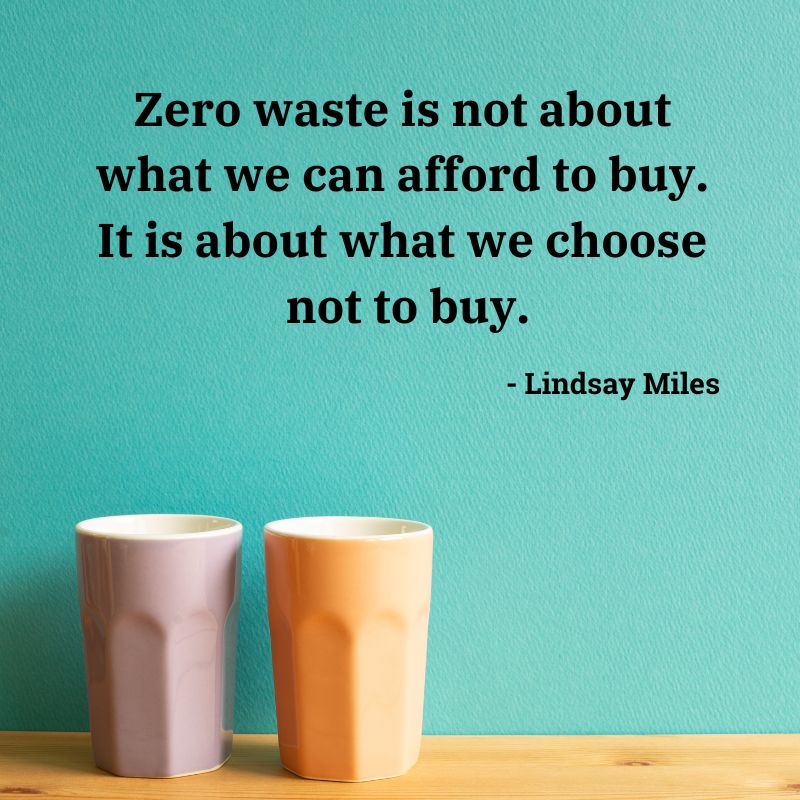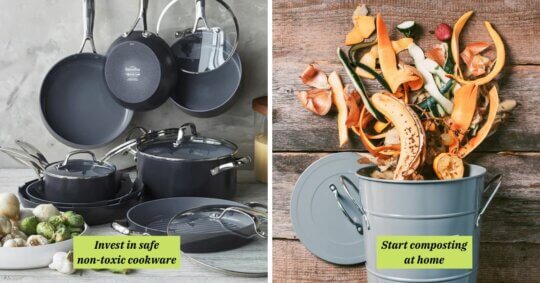When we hear about zero-waste living, the very first thing that comes to mind is getting our hands on zero-waste products or living plastic-free. Be it a reusable grocery bag or a bamboo toothbrush; we go on a spree of thoughts about all the zero-waste swaps we ever came across. This certainly makes us believe that one cannot go zero waste on a budget. However, this is not at all true.
In this article, let’s try to find an answer to the question – Is zero waste really expensive? And learn about ways to go zero waste on a budget.
Is zero-waste really expensive?

Zero waste is more about sending less waste to the landfill and keeping recycling as a last resort. It is more about focusing on what we need instead of what we want. As Lindsay Miles, the author of the book The Less Waste No Fuss Kitchen, quite rightly says, “Zero waste is not about what we can afford to buy. It is about what we choose not to buy.” So, yes, you can go zero waste on a budget by following the basics of a zero-waste lifestyle.
It is possible that some of us might not have easy access to affordable zero-waste products. Or, due to low demand and high manufacturing costs, chances are certain zero-waste alternatives cost more than conventional products. And so, it can be slightly more expensive to opt for certain zero-waste alternatives. But let’s look at this with a different lens.
Waste not, want not!
When transitioning to zero-waste living, you will realize you need fewer things than you actually thought. Moreover, you will be more mindful when using those zero-waste products. Even if you’re going for zero-waste swaps that cost you a little more than usual, they sure as hell will last much longer and be the safer choice, than conventional options. Besides, you will also buy less when shopping for zero-waste products.
When talking about zero-waste swaps for your skincare regime, the zero-waste alternatives are not just packaging-free but are also safer and free of harsh chemicals. Remember, you only need a pea-sized amount of a cleanser, a few drops of serum, a dollop of moisturizer, and so on. Another good example could be – A reusable water bottle. It will cost you more than the bottled water you buy, but it will last for a few years This makes such affordable zero-waste products worth it and not really expensive, in the long run.
Another thing to note here is that not everything needs to be done at once. If you cannot find affordable zero-waste alternatives, start slow and do things that will not be too heavy on your pocket. This way, you will have the satisfaction of doing your bit for the planet while at the same time not feeling too overwhelmed.
Here’s how you can go zero waste on a budget
Going zero waste on a budget doesn’t have to be expensive. If you’re willing to invest a little extra time and effort, though, you can drastically reduce your waste and save money in the process. Here’s a detailed guide to help you achieve a zero-waste lifestyle without burning a hole in your pockets.
1. Start off with things you already own
Check your wardrobe, kitchen storage, or any other places in your home where you keep things you no longer use. We are sure you will come across a lot of items that are useful yet sitting pretty in the back. Put these things to good use. It can be anything from clothes you no longer wear to ingredients you bought for some viral recipe that you never cooked. It is important to know and use what you already have with you before you go out to buy new stuff. This way, you waste less and use more.
2. Repair over renew
If there are items you no longer use because they are broken or torn, it is best to get them repaired instead of buying new items. Buying new things not only increases the waste you generate but will also cost you more. In case the item is beyond repair, either give it for exchange in case of appliances or drop it off at a recycling center. Make sure to dispose of common household items the right way, if you cannot repair or reuse them.
3. Upcycle, reuse, and DIY
Be it your closet or the pantry, get creative (or simply Google it!) Look for upcycling hacks; turn things that you no longer use into items that might be useful to you. For example, an old t-shirt can be made into cleaning rags or a cool grocery bag. Moreover, it is a lot cheaper to use DIYs to opt out of using expensive products. This doesn’t mean you should skip buying your sunscreen and DIY it. No, instead, go for DIYs that actually work without causing any discomfort, such as cleaning products.
Related: 10 Creative Ways To Reuse And Recycle Clothes To Keep Them Out Of Landfills
4. Review your finances
Have a closer look at what you’re spending on. Understand where your money is going. There are various ways to cut down expenses by being a little mindful at times. It could be dropping items from your grocery list as well as cutting back on energy at home. You will be shocked at the amount of money you can save by making small changes to your lifestyle.
5. Think twice before adding it to the cart
It can be tempting to pick certain items when you’re walking down the aisle in a store or surfing your favorite online shop. This could be anything from chocolates and munchies to clothes, especially when there are offers flashing right in front of you. The best way to zero-waste shopping is to make a list of things you need beforehand and stick to it, no matter what! In case you find something that you really need, give it a second thought. Wait till you finish picking up all the rest of the products on your shopping list; only if you still need that item, then go for it.
6. Swap, borrow, and thrift
Another way to save a few bucks is to borrow and swap things (including clothes, appliances, books, etc.) with your family and friends. This helps to save money and still get the things you need. If that’s not an option, then try buying secondhand or from thrift shops. However, be mindful when thrifting. Don’t thrift for items that you might not need, and in case you do get them, it’s okay to return some of these items. After all, when you thrift, the primary objective is to prevent those items from ending up in landfills.
Related Article: Is Thrifting Really Sustainable? A Look Into This Viral Social Media Trend
7. Choose swaps that will save you money in the long term
Check your shopping list, and replace single-use items such as toilet rolls or pads/ tampons with zero-waste alternatives. Try one zero-waste product at a time and not all at once. Think twice and understand if it is practically possible for you. For example, you might not need beeswax wrap in your kitchen as you can easily use cloth wraps already available at home. But you might want to swap your cotton t-shirt with an organic cotton t-shirt when you shop next. So, opt for zero-waste swaps that are good for you.
8. Buy local in bulk (if possible) and in your own containers
If you have the option to buy in bulk, go for it. Try calculating your expenses for when you buy household items in part throughout the month versus when you buy them all at once. The cost of buying in bulk will surely be less than buying in parts. Also, there are certain stores that allow you to take your own containers, to avoid unnecessary packaging. This will help you cut down on a lot of packaging waste.
9. Become a pro at storing food
Storing things properly is extremely important when it comes to zero-waste living. It’s an important step in reducing waste, especially when it comes to food waste. Freeze what needs to be frozen, wrap your greens in a cloth, and put the grains in a clean and dry part of the pantry/ kitchen. Use materials like glass, stainless steel, and silicone instead of plastic containers. Put lemons in water to keep them fresh. This way, your food items will last longer, which means you will need to buy less and will save money.
10. Don’t get fooled by the labels
Do your research well whenever buying a new zero-waste product. It is easy to get fooled by labels and false claims made by brands to sell their products. It is best to look for sustainability certifications to be sure about the things you’re buying, as ‘greenwashing‘ is pretty common nowadays.
Related: How To Tell If A Brand Is Ethical Or Sustainable, To Avoid Getting Greenwashed
Final Takeaway
While a zero-waste lifestyle might seem slightly unobtainable, it’s actually very possible on a good budget. All you need is the determination to make purchases and lifestyle choices in such a way that your waste is minimal. Avoid buying conventional items, which often come wrapped in excessive packaging.
Even if you currently consider yourself a wasteful person living on a tight budget, you can still significantly reduce your waste. With a little extra work and some conscious changes to your purchasing habits, you’ll be on your way towards living a considerably zero-waste lifestyle and being happier for it.
Here are some useful and simple tips for zero-waste living, that will surely help you on your journey.










